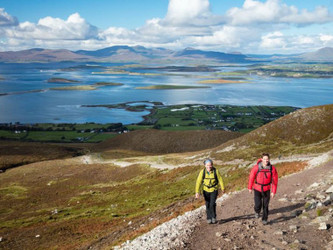The 5 Most Scenic Places to Get Your Instagram on in County Mayo
Posted by Adam Farley on 5th Mar 2019
County Mayo in the west of Ireland has some of Ireland’s most picturesque landscapes. It has the longest coastline of any county in Ireland, with over 700 miles of bays, beaches, sand dunes, and hard cliff faces, in addition to hundreds of islands that dot the shore. Each bend in the road offers yet another stunning vista to take in. But for the time-strapped visitor, it can be hard to know just where the perfect shot can be had. That’s why we’ve compiled this list of the best, most scenic places in Mayo for capturing the ideal Irish landscape of your dreams.
5. CLARE ISLAND LIGHTHOUSE

(Christian McLeod / Fáilte Ireland)
Standing like a sentinel at the mouth of Clew Bay, Clare Island is by far the largest of the bay’s more than 300 islands and has long been a favorite destination for those seeking escape from mainland Ireland. (The historic Clare Island Abbey dates back to the 12th century.) With a shoreline that resembles Mayo’s in miniature, the island possesses rocky cliffs and pristine, blue flag beaches. But it’s the Clare Island’s lighthouse that offers some of the most breathtaking views around. Located at the northern-most point on the island, the lighthouse has been in operation for over 200 years. Moreover, it offers bed and breakfast accommodation, making it one of the most unique places to stay during an Irish vacation.
4. BUNLAHINCH CLAPPER BRIDGE

(Mike Reynolds / Wikimedia Commons)
This long, low footbridge dates to the 1800s and is among the most unique bridges in Ireland. Spanning a wide but shallow ford along a river, the bridge was built with prehistoric construction methods consisting of 38 boulders spanned by stone slabs. At 130 feet long, it is the longest such bridge still in existence in Ireland. If you’re a fan of aggressive reflections and ancient stone construction, this bridge should be at the top of your picture list.
3. DOWNPATRICK HEAD

Dún Briste, Downpatrick Head's iconic sea stack. (Kevin Gillmore / Fáilte Ireland)
On the north coast of County Mayo, 30 minutes north of Ballina by car, lies Downpatrick Head, a place that combines historical importance with unrivaled natural majesty. Rising over 130 feet from the sea, the area is named for St. Patrick, who founded a church here, the ruins of which can still be seen today, in addition to a stone cross and the remains of an ancient holy well. From the cliff’s edge, you can also catch sight of Dún Briste (broken fort), a crass-topped sea stack where the multi-colored stone layers of geographic history are piled on top of each other just off shore. According to legend, St. Patrick created the sea stack when he became enraged with a pagan chieftain for refusing to convert to Christianity. He dug his crozier into the ground, splitting the stack from land and leaving the chieftain on its top. Historically, Downpatrick Head has been a site of religious pilgrimage as a result of its association with St. Patrick, and today a special mass is held on the last Sunday of every July, known as Garland Sunday, to mark the significance of the location.
2. KEEM BAY, ACHILL ISLAND

(Mike Shinners / Geograph.ie)
What could be more breathtaking than a perfect horseshoe bay surrounding a sandy blue flag beach that hardly anyone knows about? Inaccessible by anything but boat or foot until the 1960s when a road was built over a former trail, the east-facing bay is perfectly sheltered from the brunt of the Atlantic weather by the Benmore cliffs to the west, Croaghuan mountain on the north, and Moyteoge Head to the south, creating a brilliantly calm beach on which to enjoy your summer vacation. The sand is the color of Grecian gold, and the long, shallow bay turns the water turquoise on a sunny day.
1. CROAGH PATRICK

Though it’s not even the tallest mountain in County Mayo, let alone Ireland, Croagh Patrick is without question the most important peak in the country. A site of religious pilgrimage and gathering for at least 5,000 years, it is here that St. Patrick fasted for 40 days and banished the snakes from Ireland during his mission to convert the pagan Irish to Christianity, creating the modern tradition pilgrimage to its summit still practiced today by hundreds of thousands of visitors. From its peak, 360º views await, including of Clew Bay’s hundreds of small islands, the well-worn trail of religious devotees that cuts up the mountains ridgeline, and unparalleled expanses of sky. You may want to wait for a sunny afternoon to make the hike, but when the clouds break, it will have been so worth it.

